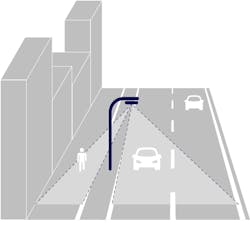Solid-state lighting (SSL) enabling technology manufacturer Tridonic has announced the new Siderea platform of building-block products that developers can easily use to quickly design smart outdoor lighting products. Moreover, the portfolio includes compatibility with the Paradox Engineering Smart Urban Network platform, so development teams can enable their companies to offer a turnkey smart-city system for installation in small towns with a few luminaires or in large urban areas. The modular approach to outdoor LED-based lighting products is largely standards based and future proof.
Tridonic has manufactured some modular SSL lighting products and of course its parent Zumtobel makes lighting products and offers connected systems. But Tridonic is mostly focused on drivers, sensors, and connectivity building blocks. The company has a number of connectivity options in its portfolio, but the Siderea announcement marks what is a turnkey bottom-to-top portfolio that will enable lighting manufacturers to greatly accelerate product development and have a ready-made option for the central management system (CMS) from Paradox Engineering to supply municipalities.
Still, the Siderea portfolio is standards based. Developers could mix and match technologies on a smart city stack, enabling manufacturers to offer different types of wired or wireless networks in a smart city deployment and even different feature sets from what Paradox supports. The offering is intended to be flexible as well as scalable.
Tridonic drivers would be the typical foundation of a development. The new PRE D4i drivers are based on Zhaga Book 18 and the D4i standard from the DALI Alliance. Note what is officially the DiiA (Digital Illumination Interface Alliance) that promulgates DALI (Digital Addressable Interface Alliance) recently swapped its branding to DALI Alliance. We’ve written quite a lot about the D4i standard, which utilizes DALI-2 as an internal intra-luminaire interface between the driver and sensors/wireless networks/controllers. D4i simplifies the path to smart and connected luminaires.
The Book 18 compatibility, meanwhile, enables a developer to simply connect a module to a luminaire externally that can integrate the aforementioned sensors, wireless interface, and/or controller. So the luminaire network choice and feature set can be finalized after the baseline luminaire manufacturing process is complete. With the Siderea offering, Tridonic is offering what it calls an RF Multimaster Controller. The module supports the Paradox Smart Urban Network, or potentially any mesh network based on the IEEE 802.15.4 physical-layer network and the 6LoWPAN protocol based on IPv6. Tridonic supports several wireless schemes as we noted earlier, but as we wrote in an article a few years back has touted Internet Protocol (IP) to the end node as the most robust technical option.
Tridonic itself will ensure the scalability of Siderea in terms of application scenarios. The company said that it will develop a turnkey autonomous control system for smaller networks of, say, 60 street lights with zone support within that inventory. Details of that control system are not yet available.
The system will further support autonomous dynamic lighting that adapts to the environment. For example, an individual luminaire or small group of luminaires could raise light levels when a pedestrian is present (see nearby graphic). And it enables dynamic programmable control, for example, lowering light levels late at night when traffic lessens.
Tridonic said it will also support advanced features from bottom to top of the portfolio. For example, consider tunable lighting. We most often write about tunable lighting relative to indoor applications. But there have been some tests of such capability outdoors. We covered an outdoor tunable trial in Minnesota a few years back.
Tridonic will offer drivers that have multi-channel LED support for tunable output. And the application will also be supported at the system level. The intended goal could simply be ambience, or it could be positive circadian impact.
For up-to-the-minute LED and SSL updates, why not follow us on Twitter? You’ll find curated content and commentary, as well as information on industry events, webcasts, and surveys on our LinkedIn Company Page and our Facebook page.







